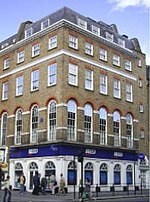The Barley Mow, Marylebone
Buildings and structures in MaryleboneCommercial buildings completed in 1791Grade II listed pubs in the City of WestminsterLondon building and structure stubsNational Inventory Pubs ... and 3 more
Pub stubsUnited Kingdom listed building stubsUse British English from August 2014

The Barley Mow is a grade II listed pub located at 8 Dorset Street, Marylebone, London, W1.It is on the Campaign for Real Ale's National Inventory of Historic Pub Interiors. Public houses on this list have remained relatively unchanged since World War II or at least for the past thirty years. It was built in 1791 and is rumored to be the longest standing building in Marylebone. It is also one of the last remaining free houses in central London. The Barley Mow is a pub with listed wooden booth seating, occasional live music and Saturday quizzes.
Excerpt from the Wikipedia article The Barley Mow, Marylebone (License: CC BY-SA 3.0, Authors, Images).The Barley Mow, Marylebone
Dorset Street, London Marylebone
Geographical coordinates (GPS) Address Website Nearby Places Show on map
Geographical coordinates (GPS)
| Latitude | Longitude |
|---|---|
| N 51.5197 ° | E -0.1556 ° |
Address
Acacus
Dorset Street 7A
W1U 7NG London, Marylebone
England, United Kingdom
Open on Google Maps









